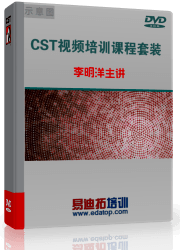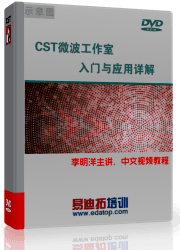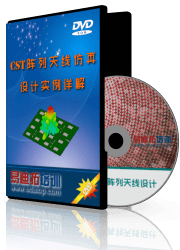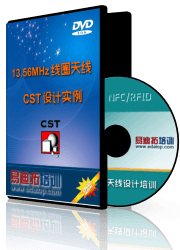- 易迪拓培训,专注于微波、射频、天线设计工程师的培养
Coaxial Connector (Thermal) - CST2013 MWS Examples

General Description
This example shows the S-parameter calculation and thermal co-simulation of a coaxial connector. It consists of inner and outer conducting cylinders of different materials with electric and thermal conductivities. The transient and thermal solver are used for the calculations.
Structure Generation
The structure is constructed by only using primitive shapes such as cylinders. For a detailed sketch of the geometry see the figure below. Different materials are defined and applied which need to exhibit thermal conductivities as well as electric losses.

Solver Setup
For the excitation of the transient simulation two waveguide ports are used at the ends of the structure. Further, field monitors are defined at 7.5 GHz for the following thermal analysis.
After the transient analysis, a result template automatically starts the stationary thermal solver. The fields of the excitation of port 1 are used as source fields.
Post Processing
The S-parameters and the time signals can be accessed through the 1D Result folder in the navigation tree.
Under the 2D/3D Results folder in the navigation tree, the 3D-results of the E-Field and H-Field can be viewed and analyzed. After the thermal co-simulation, the temperature distribution and thermal volume losses are also displayed in this folder.
Temperature | Thermal Volume Losses |
|
|
CST微波工作室培训课程套装,专家讲解,视频教学,帮助您快速学习掌握CST设计应用
上一篇: Dielectric Resonator Filter - CST2013 MWS Examples
下一篇: Dielectric Sphere - CST2013 MWS Examples
CST娑擃厽鏋冪憴鍡涱暥閸╃顔勯弫娆戔柤 | More...
 最全面、最专业的CST微波工作室视频培训课程,可以帮助您从零开始,全面系统学习CST的设计应用【More..】
最全面、最专业的CST微波工作室视频培训课程,可以帮助您从零开始,全面系统学习CST的设计应用【More..】
频道总排行
- Rectangular Waveguide Tutorial
- FSS: Simulation of Resonator
- CST2013 MWS Examples: Thermal C
- Dipole Antenna Array - CST201
- CST MWS Examples - CST2013 M
- Microstrip Radial Stub - CST2
- Dielectric Resonator Antenna -
- Interdigital Capacitor - CST20
- CST2013 MWS Examples: Biological
- Lossy Loaded Waveguide - CST2










